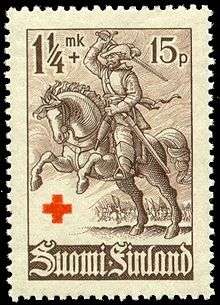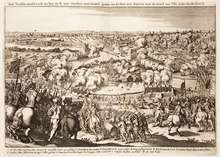Hakkapeliitta


Hakkapeliitta (Finnish pl. hakkapeliitat) is a historiographical term used for a Finnish light cavalryman in the service of King Gustavus Adolphus of Sweden during the Thirty Years' War (1618 to 1648). Hakkapeliitta is a 19th-century Finnish modification of a contemporary name given by foreigners in the Holy Roman Empire and variously spelled as Hackapelit, Hackapelite, Hackapell, Haccapelit, or Haccapelite. These terms were based on a Finnish battle cry hakkaa päälle (English: strike upon [them]; Swedish: hacka på), commonly translated as "Cut them down!"
The hakkapeliitta-style cavalry was first used during the Polish-Swedish Wars of the late 16th century. In the early 17th century the cavalry led by the Field Marshal Jacob De la Gardie participated in campaigns against Poland and Russia. The Hakkapeliitta cavalry men led by Field Marshal Gustaf Horn were vital to the Swedish victories in Germany during the Thirty Years' War.
The Finnish military march Hakkapeliittain Marssi is named after hakkapeliittas.
Tactics
The Hakkapeliitta were well-trained Finnish light cavalrymen who excelled in sudden and savage attacks, raiding and reconnaissance. The greatest advantage of the fast and lightly armored Hakkapeliitta cavalry was its charge. They typically had a sword, a helmet, and leather armor or a breastplate of steel. They would attack at a full gallop, fire the first pistol at twenty paces and the second at five paces, and then draw the sword. The horse itself was used like another weapon, as it was used to trample enemy infantry.
The horses used by the Hakkapeliitta were the ancestors of the modern Finnhorse; they were strong and durable.
Organization
The Swedish army then had three cavalry regiments from Finland:
- Nyland and Tavastehus County Cavalry Regiment (Swedish: Nylands och Tavastehus läns kavalleriregemente)
- Åbo and Björneborg County Cavalry Regiment (Åbo och Björneborgs läns kavalleriregemente)
- Viborg and Nyslott County Cavalry Regiment (Viborgs och Nyslotts läns kavalleriregemente)
Their most famous commander was Torsten Stålhandske (surname meaning "steelglove"), who was commissioned as a lieutenant-colonel with the Nyland and Tavastehus Cavalry Regiment in 1629 and led it for the first time in the Thirty Years' War.
The original provincial regiments (landskapsregementen) had been raised by splitting the old Grand regiments (Storregementen, also "Land regiments" (landsregementen), organized by Gustavus Adolphus at the end of the 1610s, forming 21 infantry and eight cavalry regiments as written in the Swedish constitution of 1634.
Famous battles
The main battles in which the Hakkapeliitta took part during the Thirty Years' War were:
- Breitenfeld in 1631
- Lech in 1632
- Lützen in 1632
- Nördlingen in 1634
- Leipzig in 1642 (also known as the Second Battle of Breitenfeld or the First Battle of Leipzig)
- Jankau in 1645
- Lens in 1648
200 Hakkapeliitta were also part of the army which King Karl X Gustav of Sweden led across the frozen Danish straits in the winter of 1658, which enabled him to conquer Skåneland from Denmark in the Treaty of Roskilde.
Despite popular Finnish belief, the Hakkapeliitta were not particularly well-known on the Central European battlefields; Finns are rarely mentioned in Central European sources of the time, even though it is not known, many Finnish soldiers served under the Swedish Empire. [1] During the era of the Swedish Empire of the 17th century, the Finnish cavalry was constantly used in Germany, Bohemia, Poland and Denmark. Parts of the cavalry were stationed in Estonia and Livonia.[2]
Aulis J. Alanen described the Finnish cavalry:
"Our [Finnish] Hakkapelites cannot have been any sort of fine representatives. I should mention a parade of the Gustaf Adolf troops in the Thirty Years' War, while the king still lived. At first went the blue, yellow, green etc. mercenaries of the regiment in their flashy gear. Then came, clothed so-so, bridles and baldricks repaired with birch bark and cord, legs hanging from the backs of their small, shaggy horses, cutlasses dragging on the ground, a troop of hollow-cheeked but stern-eyed men. When the Dutch ambassador inquired who they were, the last rider, a fat German Quartermaster [kuormastovääpeli] in charge of the cargo proudly replied "The royal Life Guards: Finnish, pärkkele!".
In popular culture
- A song by alternative rock/metal band Tears of Magdalena titled "Cut em' Down" tells also legends of Hakkapeliitta light cavalry men.
- The Bearkillers, a protagonist faction in S.M. Stirling's Emberverse series, uses this as their battle cry.
- In the video game Civilization V, the Hakkapeliitta are one of two unique units for the Swedish civilization, replacing the generic Lancer. (The other is the Caroleans, which replace the generic Rifleman, under the later kings Charles XI and XII.)
- In the video game Empire: Total War, while playing as Kingdom of Sweden, player receives one unit of Finnish Hakkapeliitta Light Cavalry and is later able to recruit more if Military Governor is present in Finland.
- In the Japanese anime Jormungand, during episode 12, Major Sophia Velmer (known as Valmet, a Finnish ex-UNFID) cries "Hakkaa Päälle!" before attacking Cheng Guoming.
- Hackapells may be hired as mercenaries by the Dutch civilization in Age of Empires III
- The upcoming, and final, module of the Advanced Squad Leader board game system, depicting the Finnish forces in WWII, will be entitled Hakkaa Päälle!
- Nokian Tyres makes snow tires called Hakkapeliittas.
- Hakkapeliitta's feature in Eric Flint's 1632 novel series as one part of Gustav II Adolf's armies.
- The song "Rex Regi Rebellis" by Finnish metal band Turisas describes the adventures of the Hakkapeliitta and includes the battle cry Hakkaa päälle pohjan poika! (Strike them down, son of the North!).
References
- ↑ Karasjärvi, Tero. "Historiallisia Arvosteluja 24/2001: Sadan vuoden sotatie" [Historical [book] reviews 24/2001: Sadan vuoden sotatie] (in Finnish). Retrieved December 25, 2009.
Hakkapeliitat eivät myöskään saavuttaneet mitään kummoisempaa mainetta Euroopan sotakentillä. Hyvin harvat aikalaislähteet mainitsevat erityisesti suomalaiset sotilaat [...]
- ↑ Talaskivi 1977, pages 77-81
External links
- Midi tune
- Orchestral mp3 version (archived link, 8 April 2005) by the Finnish Cavalry Tradition Band(archived link, 10 April 2006)